Random Thoughts
China On My Mind
September/25/2008
Because I was
working on some important projects during the
Olympics, I'm just now getting through all of the
DVRs of the event. The incredible spectacle that
played out in Beijing is still on my mind. When I
visited Beijing in 2006, it was hard to imagine what
how the city . . . exploding with mind-boggling
growth and clouded with gritty, grimy smog would step
into the world spotlight on 08-08-08. I was most
curious about the Bird's Nest. For the week during
which our PPA delegation visited with Chinese
photographers, our accommodations directly overlooked
the Bird's Nest construction area. To see the
finished structure at the Opening Night ceremonies
was magical, considering what the iconic structure
shown in the images below looked like only two years
earlier.


Here is a photo that I took in May, 2006:

No, this is not a case of my exposure being off. I took this on a "sunny" day, and I actually had to do a few Photoshop tricks to make the image legible. This is the smog that caused so much pre-Olympic concern on the part of athletes and trainers. I'm not sure that a democratic country would have been as successful as the Chinese were in convincing citizens to abandon their cars and shut down belching factories so that the city could be seen in a far better light. Several timely smog-dampening rains also helped to freshen the city. On a smog-free day, Beijing is an incredibly frenetic moving picture, juxtaposed with ageless treasures of art and architecture that can only be fully appreciated through the stillness of the studied human eye or through the aperture of a still camera. Occasionally the TV coverage did justice to the poetry of these contradictions of motion and serenity.
After replaying parts of the Opening Ceremonies several times and marveling at what I saw, I believe the true artistry of that extraordinary choreography was best revealed in some still news photographs that I found on Boston.com. Take a look and see what you think by clicking here. I believe the still camera did a far better job of showing what director Zhang Yimou created: a magnificent melding of people and technology . . . an deliberate metaphor that one cannot fulfill its destiny without the other.
I'm a sports nut, so I devour Olympic Games. Until Beijing, sadly, the most indelible games in my memory was the Munich Olympics, which was overshadowed by an unspeakable act of terrorism. Beijing had it's moment of horror for an American family singled out by a deranged individual. That tragedy aside, I still can't wrap my head around what went on in and around the games, because I suspect that the most important story of this Olympiad will be years in the telling. Like most Westerners who visit there, I see China as a huge question mark. How will this teeming population who, now that they have sampled the bounty that capitalism can produce, and now that they have felt the sense of pride in what they and their leaders have accomplished on the world stage . . . what will they do for an encore? How will they reconcile their modern aspirations with their ancient heritage? How will their potentially volcanic mixture of capitalism-wrapped-in-totalitarianism manage to coexist with the rest of the world?
I would love to visit Beijing again if for nothing more than to see how fast their world has turned and to learn how the photographers I met there are faring in their advance on capitalism. What I observed in 2006 is that most businesses still have at least some government strings that prevent them for achieving self-determination: some definitely more than others. The downtown studio shown below was still operating in "the old way." The plaque on the grand building said: "Top Ten Enterprises of National Photograph Industry," but the government-like interior and the faded portraits in the window said otherwise.
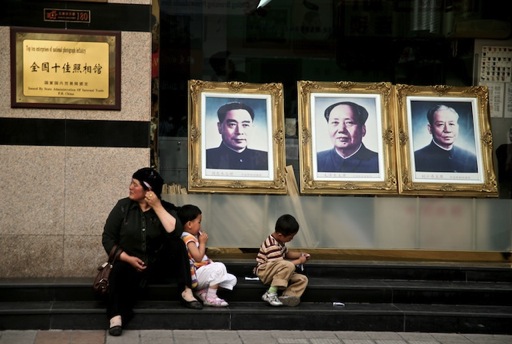
This decidedly modern studio was located in a suburban community built through a cooperative arrangement between the Chinese and Canadian governments. It was thoroughly up to date and housed in a beautifully constructed neo-Craftsman bungalow. Interestly, the overhead burden of the building alone would sink an American business.

Most of the studios looked like and seemingly operated much like the mom-and-pop studios that once dominated our profession.

While they were only a few years behind with their digital technology, they face an uphill battle because of exceptionally low prices that dominate their market. I suspect this will continue until middle class citizens can afford to decorate their homes more lavishly and they learn about the decorative potential of photography. When this happens, the dam will burst.

With all of this rolling around in my head, I began looking through some of the photos I took during my two visits to China to find a few that represented what I felt about China in 2006, so that I can use them as a baseline by which to measure the future I might see there on another visit. Nothing really stood out. But what I enjoyed revisiting most were the simple pictures of people going about their business in a remarkable country on the brink . . . a country that provokes thoughts that run in every direction at once. China is often on my mind.
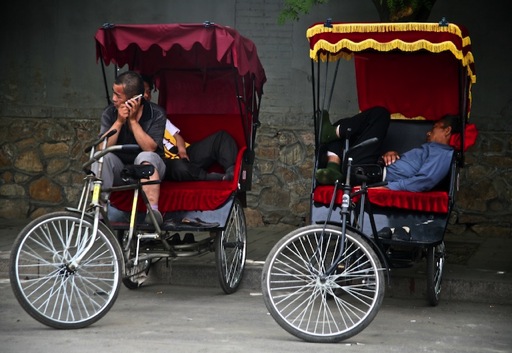
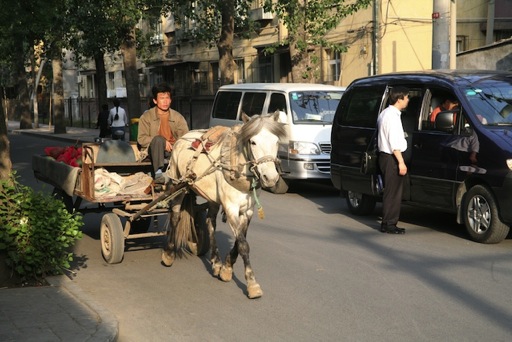
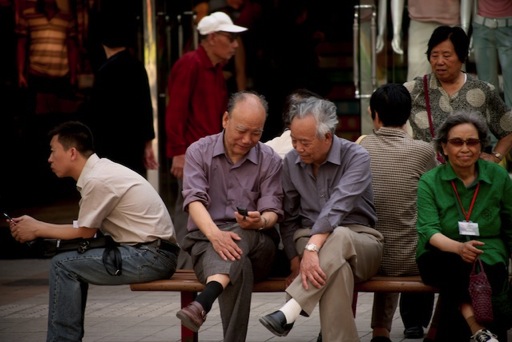


Here is a photo that I took in May, 2006:

No, this is not a case of my exposure being off. I took this on a "sunny" day, and I actually had to do a few Photoshop tricks to make the image legible. This is the smog that caused so much pre-Olympic concern on the part of athletes and trainers. I'm not sure that a democratic country would have been as successful as the Chinese were in convincing citizens to abandon their cars and shut down belching factories so that the city could be seen in a far better light. Several timely smog-dampening rains also helped to freshen the city. On a smog-free day, Beijing is an incredibly frenetic moving picture, juxtaposed with ageless treasures of art and architecture that can only be fully appreciated through the stillness of the studied human eye or through the aperture of a still camera. Occasionally the TV coverage did justice to the poetry of these contradictions of motion and serenity.
After replaying parts of the Opening Ceremonies several times and marveling at what I saw, I believe the true artistry of that extraordinary choreography was best revealed in some still news photographs that I found on Boston.com. Take a look and see what you think by clicking here. I believe the still camera did a far better job of showing what director Zhang Yimou created: a magnificent melding of people and technology . . . an deliberate metaphor that one cannot fulfill its destiny without the other.
I'm a sports nut, so I devour Olympic Games. Until Beijing, sadly, the most indelible games in my memory was the Munich Olympics, which was overshadowed by an unspeakable act of terrorism. Beijing had it's moment of horror for an American family singled out by a deranged individual. That tragedy aside, I still can't wrap my head around what went on in and around the games, because I suspect that the most important story of this Olympiad will be years in the telling. Like most Westerners who visit there, I see China as a huge question mark. How will this teeming population who, now that they have sampled the bounty that capitalism can produce, and now that they have felt the sense of pride in what they and their leaders have accomplished on the world stage . . . what will they do for an encore? How will they reconcile their modern aspirations with their ancient heritage? How will their potentially volcanic mixture of capitalism-wrapped-in-totalitarianism manage to coexist with the rest of the world?
I would love to visit Beijing again if for nothing more than to see how fast their world has turned and to learn how the photographers I met there are faring in their advance on capitalism. What I observed in 2006 is that most businesses still have at least some government strings that prevent them for achieving self-determination: some definitely more than others. The downtown studio shown below was still operating in "the old way." The plaque on the grand building said: "Top Ten Enterprises of National Photograph Industry," but the government-like interior and the faded portraits in the window said otherwise.

This decidedly modern studio was located in a suburban community built through a cooperative arrangement between the Chinese and Canadian governments. It was thoroughly up to date and housed in a beautifully constructed neo-Craftsman bungalow. Interestly, the overhead burden of the building alone would sink an American business.

Most of the studios looked like and seemingly operated much like the mom-and-pop studios that once dominated our profession.

While they were only a few years behind with their digital technology, they face an uphill battle because of exceptionally low prices that dominate their market. I suspect this will continue until middle class citizens can afford to decorate their homes more lavishly and they learn about the decorative potential of photography. When this happens, the dam will burst.

With all of this rolling around in my head, I began looking through some of the photos I took during my two visits to China to find a few that represented what I felt about China in 2006, so that I can use them as a baseline by which to measure the future I might see there on another visit. Nothing really stood out. But what I enjoyed revisiting most were the simple pictures of people going about their business in a remarkable country on the brink . . . a country that provokes thoughts that run in every direction at once. China is often on my mind.



|
Pro Photography Now: The Good, The Bad, The Ugly
August/31/2008
After spending a week at home without the rigors of
traveling that sometimes muddle my brain, I've done
some thinking about the state of business among
studio photographers. These reflections were prompted
by the fact that I'm nearing the end of my teaching
schedule this year . . . a year in which I've taught
more classes to more students than in any other
period of my career. For years you couldn't give away
a business class; today there are waiting lists for
marketing and management workshops and seminars, and
the classrooms are filled to overflowing. This shift
should come as no surprise, given the huge numbers of
new photographers in the industry, the prevalence of
automatic prosumer cameras, and the ongoing
challenges of still-evolving digital technology.
Nonetheless, I suspect that some of the things I've
observed this year might be of interest, given the
fairly chaotic nature of our industry today. So here
goes:

The Bad
The following observations come from interacting with the photographers I’ve seen in class or worked with personally in 2007 and 2008 (they amount to several thousands), as well as to information I have received from a group of well-respected instructors and consultants with whom I regularly converse. I believe these problems are fairly widespread.
The Ugly
When markets are unstable, “The Bad” slips easily into “The Ugly,” resulting in an out-of-control business situation that is very stressful for the photographer as well as disheartening for instructor or consultant who wants to help. No matter how hard the photographer is willing to work, or how well-intentioned the helper is to pull the unstable business back from the brink of disaster, when business weaknesses are so pervasive, their consequences can be impossible to reverse. So here are my top warning signs that constitute The Ugly in today’s industry:
So where do we stand?
In spite of the fact that Bad and Ugly business practices in the studio industry today have created a fairly chaotic environment for photographers and consumers alike, I’m pretty optimistic. I can still remember hearing stories from my early teachers about the chaos created when photographers moved from black-and-white film to color: They had to cope with new lighting systems; they were no longer able to control their images in a black-and-white darkroom; and the first color films were unstable and did not portray color accurately; and finished prints faded very quickly. But when photographers learned to outsource their work to professional color labs, they found they could produce products that thrilled consumers, and once they were out of the darkrooms, they could spend more time with clients and do a better job of marketing and managing. Soon they began selling large, decorative portraits that earned places of honor in homes and offices, finally achieving the deserving status of custom artwork. I often refer to this era as a “Golden Age” for studio photographers. While we are nowhere near a Golden Age for digital studios, signs of positive movement are abundant in the form of some of the best business models I’ve ever seen; in creativity that is being applied not only to image-making, but also to marketing and management; and in plenty of consumers who possess the money and the desire to spend it with photographers who are willing to do what’s necessary to connect with them. Many of us who teach do so in order to learn, and I’ve learned a lot this year. The bottom line I see is this: For those photographers with real vision, true creativity, and who are willing to develop the business skills that most often have to be learned through repetitive education and practice, there are no limitations. For those who think they can get by on passion alone and those who refuse to deal with the reality of doing business, unless they change directions quickly, they’ll be gone . . . sooner rather than later. One thing that is absolutely clear to me: In today's market, you must either buckle down and behave like a business, or move on to something else.
The Good
- quality of photography today is better than I've ever seen it. Photoshop allows photographers to achieve artistry and style far faster than during the film years. I can only marvel at the skills of those younger photographers who have studied Photoshop and graphic design in high school. But it's not just the new guys who are reaching these heights: Those veteran photographers who were highly skilled in traditional photography and who have embraced digital technology are really soaring! And yes, Photoshop can make even a mediocre photographer look good; but Photoshop cannot correct bad business practices.
- More and more photographers are recognizing that unless you wish to do mass-production photography, today’s business climate requires a business concept that is designed to appeal to a specific target market instead of trying to be all things to all people. They understand that the new breed of consumer appreciates a specialist rather than a generalist, and they are learning that this type of business is much easier to run. Note that I did NOT say "easy to run" :-).
- It's great to see how some industry veterans are reinventing their businesses, using the strong technical skills and the business knowledge they've acquired over time to re-brand their studios. I just wish there were more of them.
- In contrast to their predecessors, younger photographers generally are more interested in learning about how to run a business. Perhaps this is because digital cameras have shortened the technical learning curve for a generation that was brought up around visual media, or it is a function of their more material upbringing. Frankly, I don't care: It's exciting to see a really talented photographer who is as concerned about Cost of Sales as he or she is about f/stops.
- The "Entitlement Generation," God bless them, are now our clients. Sociologists and marketers are all over this fascinating new consumer group that is well educated, well financed, and will deny themselves nothing when the marketplace offers them something appealing. Understanding how they think and act is central to attracting these upscale clients. The good news is that all you have to do is Google "The Entitlement Generation," and you’ll find lots of fascinating information.
- The style of today’s home décor lends itself to using portraits as decorative focal points throughout the house. There literally are no limits on photography as customized, personalized art for multiples rooms, making it more valuable than “just a photo.”
- I'm enthralled by some of the newer breed of photographers who find so much creativity in marketing that they put as much energy into this aspect of the business as they do in creating exciting images; it's a great formula for success.
- Photographers who are paying attention to their numbers are making substantially more money than their predecessors. Until the publication of PPA’s 2005 Benchmark Survey in 2006, we had only anecdotal evidence of an emerging prosperity in segments of the photography industry: The survey showed that the top 15% of participants were keeping more of every dollar spent with them than any other groups for which we have records. If you are a PPA member, you can download the survey by clicking on the graphic below:

The Bad
The following observations come from interacting with the photographers I’ve seen in class or worked with personally in 2007 and 2008 (they amount to several thousands), as well as to information I have received from a group of well-respected instructors and consultants with whom I regularly converse. I believe these problems are fairly widespread.
- Many veteran photographers who have not kept abreast of consumer trends are having a tough time making a go of it, especially those whose operational debt has piled up year after year. In some cases, I fear their inability to adapt to change might end their careers prematurely. Those who possess solid business skills have the greatest likelihood of turning their businesses around, but sadly there are many who may never accept the fact that adaptation is vital to business longevity, even when you do business in an artistic medium.
- Only a small percentage of photographers, whether "born digital" or former film shooters, have developed truly efficient digital workflow systems. This is in spite of the fact that both internal workflow technology and highly efficient outsourcing options are now plentiful. Achieving truly efficient workflow systems requires a commitment of time and/or money, both of which typically are in short supply in an out-of-control business. This fall-down point alone can doom a business to the kind of death-by-duck-bite burnout that results from losing countless hours to the mind-numbing frustration of inefficient, unprofitable hours spent in the studio.
- Overshooting is now the rule rather than the exception, and this make inefficient workflow even more harmful. Once-careful film shooters are now awash in an avalanche of images that take hours to edit — hours they should be spending in profit-producing activities such as marketing and management, or in personal fulfillment by enjoying a life outside of the studio. And those who are learning on the job . . . need I say more? I’ve heard every excuse in the book as to why it is necessary to photograph so excessively, but at the end of the day the only thing that counts in business is how much of your time is being compensated, and how little time you are losing to non-profit-producing pursuits.
- The overshooting felony is compounded when photographers present the entire collection of Way-Too-Many-Images for the client to view. When the selection process becomes tedious, the photographer has failed. Period. The frustrated client knows no other way to stop the pain than to ask “Can’t I just have a little one of each of the poses?” or “Can’t you just sell me a DVD of all the images?” Part of being a true professional involves presenting the images in a manner that helps the client to determine easily which ones are the best and how they can be displayed attractively. That way there is no confusion, no conflict, and everyone wins. That way your images can be viewed and enjoyed, not stuck in a drawer or forever consigned to a hard drive. That way your images have VALUE.
- I’m seeing a widespread failure of newer photographers to create a compelling business concept that is appealing to a specific market of consumers. Instead I see lots of photographers creating the types of photographs they want to make, with little concern about what the client wishes to buy. Or they are photographing “a little of this and a little of that,” which unto itself makes compelling marketing impossible. This, in turn, dooms the studio to struggling for recognition from within “the invisible middle” of the market.
- A similar problem involves the failure to create a strong “product focus.” An example of this is deciding to create documentary-style candid portraits without determining how to sell them . . . without determining what kind of product to create that can use up the images in ways other than creating a book volume or a DVD. Without a vibrant product focus, both marketing and sales will suffer.
- Another widespread problem is failing to create a strong business identity, which is a vital first step in developing a strong brand. Every week I find new entries for my list of wacky studio names and silly tag lines that succeed only in leaving a consumer’s head spinning. It’s O.K. to have a “catchy” studio name, but it must make sense to consumers on some level of comprehension.
- Pricing and selling continue to be a challenge for the majority of the industry, especially among those who came into photography because it is fun to do. Even when taught how to price and sell, I still see photographers who seemingly cannot master these critical business skills. Furthermore, the concept of having a selling plan continues to challenge the average photographer. By “selling plan” I mean a step-by-step progression of educating clients, obtaining their expectations, and satisfying those expectations to make sales a naturally evolving process rather than an antagonistic undertaking.
- Weaknesses in pricing and selling are the likely culprits that cause too many photographers to infer that the only effective means of promoting to consumers is to advertise price reductions, which typically dooms profitability. This situation is not likely to improve until a photographer masters profit strategies and learns more about consumer buying motives.
- Effective marketing continues to be a chronic industry-wide problem, in spite of the fact that so much education and so many resources are available to help photographers achieve a comprehensive marketing plan. The typical reason given for this weakness is “not enough time in my day,” and “not enough cash flow.” What is common to those who do succeed in marketing is that they know how to reach their ideal client, and they have mastered the use of human and financial resources.
- Perhaps as a consequence of so many photographers entering the industry in such a short time, I'm seeing a trend toward novice photographers — young or older — having extremely unrealistic expectations about what it takes to succeed in photography. For the first time in my experience, the majority of photographers I work with are failing to recognize that doing photography as a business requires a commitment to complicated systems development in the areas of sales, marketing, and workflow. Perfecting these systems takes time and money . . . so much of each, in fact, that it typically isn’t possible to draw a salary for several years, even with the benefit of low overhead and very little debt. The landscape is littered with inexperienced photographers who failed because they leased high-overhead spaces without enough money in the bank to finance the business and support their families until they could create a professionally mature product that could attract a sufficient number of clients to generate healthy referrals.
- When photographers get in over their heads with debt and lack business skills, way too many are trying to skip the “success steps” that truly profitable studios prove day-in and day-out are necessary to build and sustain a business. They skip pre-portrait consultations “because I’m too busy” (usually because of workflow nightmares) or because “moms today are too busy.” Yet countless successful studios find the time to meet with their clients, having developed the skills necessary to educate them that participating in the consultations is fundamental to creating successful portraits and satisfied clients. The “too busy” excuse also lies behind the profoundly self-defeating practice of putting highly salable portrait images online for selection and purchase. This is unquestionably the single most sales-defeating and relationship-destroying business practice that exists. Yes, there are a few occasions when on-line sales are helpful in a portrait business, but I can count them on 10 fingers, with a few fingers left over.
The Ugly
When markets are unstable, “The Bad” slips easily into “The Ugly,” resulting in an out-of-control business situation that is very stressful for the photographer as well as disheartening for instructor or consultant who wants to help. No matter how hard the photographer is willing to work, or how well-intentioned the helper is to pull the unstable business back from the brink of disaster, when business weaknesses are so pervasive, their consequences can be impossible to reverse. So here are my top warning signs that constitute The Ugly in today’s industry:
- Debt has always been the number-one small-business killer, and the misuse of credit cards has made excessive debt far too easy to come by and exceedingly hard to remedy.
- Debt often accumulates simply because photographers don’t know what they can afford to spend, either at home or in the studio. Rather than understanding how numbers work in a business, then implementing strategies to attack specific problems with specific solutions, over-stressed photographers assume that if they just work harder, then the business will improve. This results in the delusion of “management by hope,” rather than management by understanding.
- Self-imposed limitations can be as crippling as debt. Photographers who have convinced themselves that clients won’t pay what is a reasonable price for their photography, often are merely projecting their own self-limiting values, but this can be a critical business mistake. A businessperson must be confident that he or she is providing value to clients, and that clients, in turn, will exchange that value for their hard-earned money. If this confidence is lacking, it is difficult to become successful in business.
- Another business killer is expecting to find a magic bullet that will bring about instant success. This manifests itself in several ways: expecting others to solve everyday problems; not putting systems in place that add business stability; doing whatever a speaker, or a client, or a colleague says to do without judging whether is financially or operationally appropriate. Very few people who enter the profession of photography find that it is an easier way to make a living than they thought it would be. Most ultimately discover that owning a business is harder work than a regular nine-to-five job. Achieving the true rewards of business ownership often is a function of how quickly they adjust to and embrace this reality.
- The Internet has spawned a kind of "do-it-yourself" education system that can easily steer a new business off course. Many times this year I've asked students, "Where did you get such a cock-eyed idea that this is how you should run a photography business?" The answer inevitably is: "I read it on a forum."
So where do we stand?
In spite of the fact that Bad and Ugly business practices in the studio industry today have created a fairly chaotic environment for photographers and consumers alike, I’m pretty optimistic. I can still remember hearing stories from my early teachers about the chaos created when photographers moved from black-and-white film to color: They had to cope with new lighting systems; they were no longer able to control their images in a black-and-white darkroom; and the first color films were unstable and did not portray color accurately; and finished prints faded very quickly. But when photographers learned to outsource their work to professional color labs, they found they could produce products that thrilled consumers, and once they were out of the darkrooms, they could spend more time with clients and do a better job of marketing and managing. Soon they began selling large, decorative portraits that earned places of honor in homes and offices, finally achieving the deserving status of custom artwork. I often refer to this era as a “Golden Age” for studio photographers. While we are nowhere near a Golden Age for digital studios, signs of positive movement are abundant in the form of some of the best business models I’ve ever seen; in creativity that is being applied not only to image-making, but also to marketing and management; and in plenty of consumers who possess the money and the desire to spend it with photographers who are willing to do what’s necessary to connect with them. Many of us who teach do so in order to learn, and I’ve learned a lot this year. The bottom line I see is this: For those photographers with real vision, true creativity, and who are willing to develop the business skills that most often have to be learned through repetitive education and practice, there are no limitations. For those who think they can get by on passion alone and those who refuse to deal with the reality of doing business, unless they change directions quickly, they’ll be gone . . . sooner rather than later. One thing that is absolutely clear to me: In today's market, you must either buckle down and behave like a business, or move on to something else.
A Noteable Passing
July/05/2008
Last week I
received word that Chinese General Shoa Hua had died
at the age of 69. Three years ago, during my tenure
as president of PPA, I was privleged to meet with her
on a visit to China. The meeting was arranged by the
Chinese Photographers Association, of which General
Shoa was president. In reading her biography as
preparation for the meeting, I was astonished to
learn that she was, in fact, the daughter-in-law of
the the late Chairman Mao Zedong. So I had no idea
what to expect from our meeting, which turned out to
be among of the most memorable moments of my life in
photography.
This is the photograph that accompanied Shoa Hua's biography.
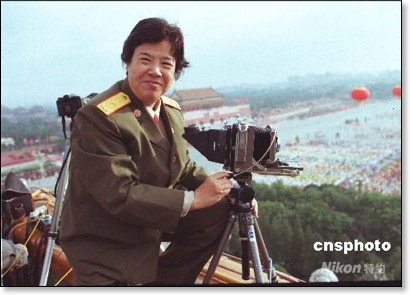
She is pictured overlooking Tiananmen Square, pursuing her life-long passion of photography. The Shoa Hua that I met in a formal hotel suite was far less imposing than her official photograph, in spite of the fact that the reaction of hotel staff clearly indicated that it was a very special honor to be in the presence a dignitary of the stature of "Chairman Shoa."

She was a gracious and genial host, and with the help of a skilled interpreter, the language barrier quickly melted away. Soon we began exchanging stories about our lives in photography and laughing about the similarities of our early experiences, such as learning to process film in a bathroom, not a darkroom; how we both encouraged women to become active in photographic associations; and I was especially pleased to learn about her desire to help Chinese photographers exploit the entrepreneurial opportunities now emerging in her country.
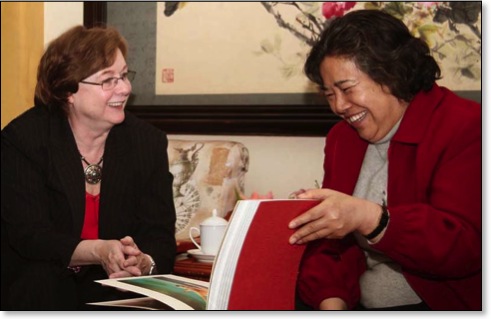
She cheerfully recounted the story of how she got her first camera after coming to live in Mao's household upon the marriage of her elder sister to Mao's first son. When she was 14 she asked Chairman Mao if it would be possible to have a camera, because she was intrigued by all the photographers who accompanied those who visited with him. He promptly provided her with a Russain-made camera. After her marriage to Chairman Mao's second son, she went on to become an accomplished scenic photographer and pursued a special interest in chronicling Chinese ballet performers and other dance events. Before we left, she gave each of her American visitors a copy of her elegantly bound, richly illustrated book entitled General Shao Hua's Photographic Art of Dancing. In the introduction she spoke passionately about the art of dance, which she described as embodying "the feeling of music, the passion of poetry, the thinking of philosophy, the depth of drama, the solid touch of sculpture, the inspiration of drawing and painting, the illusion and mystery of religion, and the true, the good, the beauty of the sympathy and love for the people . . . photographic art of dancing has really become an integral and inseparable part of my life.”
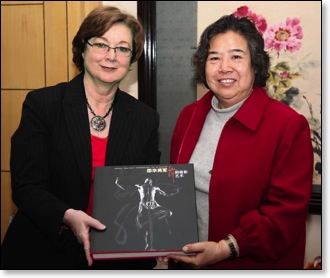
Unexpectedly, she invited her American visitors to stay for a sumptuous luncheon in a private hotel dining room.
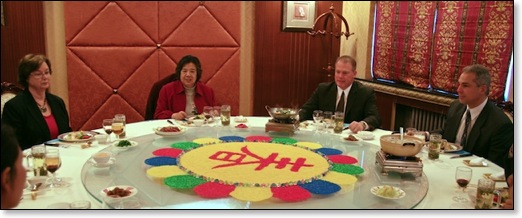
During lunch I asked if she had published any of her photographs of Chairman Mao from the time she lived in his household. "No, no, she chuckled, "my photographs of him would not be considered professional." Then she immediately made a cell phone call to arrange for us to meet with 77-year-old Mr. Lu Houmin, who became Chairman Mao's personal photographer at age 21. The next day, we visited Mr. Lu's aparetment where he graciously showed us image-after-iconic-image of Mao that still appear in history books.
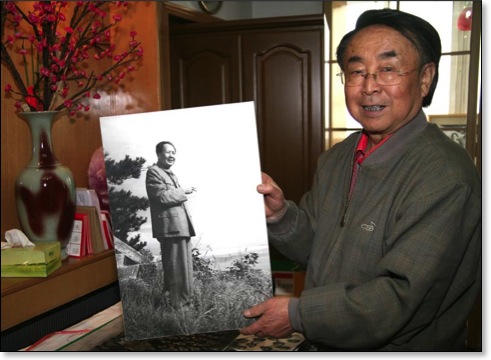
He was kind enough to pose with many of them, but my favorite was the portrait below, which shows Shoa Hua (second from the right) with Chairman Mao and the rest of the family.
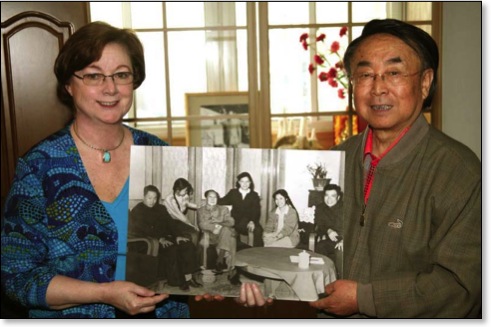
We invited both Mr. Lu and Shao Hua be special guests at the upcoming 2007 Imaging USA convention in San Antonio. Both were eager to attend, but Shoa Hua's failing health prevented her from doing so. Mr. Lu, however, made the trip and stood proudly in front of his country's flag during the introduction of international guests at the IUSA Awards Ceremony. This "first' was a truly electrifying moment.
I was disappointed that I didn't have the privilege of hosting Shao Hua in America. It would have been fascinating to see her reaction to the state of professional photography in America, as during our Beijing meeting she revealed herself to be a strong advocate of the power and importance of photography. Here's a direct quote that I recorded after the meeting: "As an adult, I observed that it was considered rude to take pictures at a public event. But I saw that people had no hesitancy about writing down details about an event in public; so I just decided to start bringing my camera to record the details.” She went on to explain how important photography is in facilitating and documenting change. She showed us a DVD made of a stream polluted with silt before it was cleaned up and made “harmonious;” then she showed her photographs of the beautiful flower gardens developed after the reclamation. “Before, people would write pages and pages about the problems of such a site and then more pages about what it became," she said. "Now you show the pictures, and everyone REALLY understands.”
As I continue to observe the delicately evolving economic and political relationship between China and America, I often have reflected on the strong currents of change and the unusual happenstance that allowed me to meet with Shao Hua on the other side of the world, where we discovered the things we have in common. Before I left that meeting, she gave me a photograph that she had made of her then three-year-old great-grandson, knowing that I had a young grandson. It was a lovely gesture that is now even more touching. I am truly grateful to have experienced this remarkable meeting.
This is the photograph that accompanied Shoa Hua's biography.

She is pictured overlooking Tiananmen Square, pursuing her life-long passion of photography. The Shoa Hua that I met in a formal hotel suite was far less imposing than her official photograph, in spite of the fact that the reaction of hotel staff clearly indicated that it was a very special honor to be in the presence a dignitary of the stature of "Chairman Shoa."

She was a gracious and genial host, and with the help of a skilled interpreter, the language barrier quickly melted away. Soon we began exchanging stories about our lives in photography and laughing about the similarities of our early experiences, such as learning to process film in a bathroom, not a darkroom; how we both encouraged women to become active in photographic associations; and I was especially pleased to learn about her desire to help Chinese photographers exploit the entrepreneurial opportunities now emerging in her country.

She cheerfully recounted the story of how she got her first camera after coming to live in Mao's household upon the marriage of her elder sister to Mao's first son. When she was 14 she asked Chairman Mao if it would be possible to have a camera, because she was intrigued by all the photographers who accompanied those who visited with him. He promptly provided her with a Russain-made camera. After her marriage to Chairman Mao's second son, she went on to become an accomplished scenic photographer and pursued a special interest in chronicling Chinese ballet performers and other dance events. Before we left, she gave each of her American visitors a copy of her elegantly bound, richly illustrated book entitled General Shao Hua's Photographic Art of Dancing. In the introduction she spoke passionately about the art of dance, which she described as embodying "the feeling of music, the passion of poetry, the thinking of philosophy, the depth of drama, the solid touch of sculpture, the inspiration of drawing and painting, the illusion and mystery of religion, and the true, the good, the beauty of the sympathy and love for the people . . . photographic art of dancing has really become an integral and inseparable part of my life.”

Unexpectedly, she invited her American visitors to stay for a sumptuous luncheon in a private hotel dining room.

During lunch I asked if she had published any of her photographs of Chairman Mao from the time she lived in his household. "No, no, she chuckled, "my photographs of him would not be considered professional." Then she immediately made a cell phone call to arrange for us to meet with 77-year-old Mr. Lu Houmin, who became Chairman Mao's personal photographer at age 21. The next day, we visited Mr. Lu's aparetment where he graciously showed us image-after-iconic-image of Mao that still appear in history books.

He was kind enough to pose with many of them, but my favorite was the portrait below, which shows Shoa Hua (second from the right) with Chairman Mao and the rest of the family.

We invited both Mr. Lu and Shao Hua be special guests at the upcoming 2007 Imaging USA convention in San Antonio. Both were eager to attend, but Shoa Hua's failing health prevented her from doing so. Mr. Lu, however, made the trip and stood proudly in front of his country's flag during the introduction of international guests at the IUSA Awards Ceremony. This "first' was a truly electrifying moment.
I was disappointed that I didn't have the privilege of hosting Shao Hua in America. It would have been fascinating to see her reaction to the state of professional photography in America, as during our Beijing meeting she revealed herself to be a strong advocate of the power and importance of photography. Here's a direct quote that I recorded after the meeting: "As an adult, I observed that it was considered rude to take pictures at a public event. But I saw that people had no hesitancy about writing down details about an event in public; so I just decided to start bringing my camera to record the details.” She went on to explain how important photography is in facilitating and documenting change. She showed us a DVD made of a stream polluted with silt before it was cleaned up and made “harmonious;” then she showed her photographs of the beautiful flower gardens developed after the reclamation. “Before, people would write pages and pages about the problems of such a site and then more pages about what it became," she said. "Now you show the pictures, and everyone REALLY understands.”
As I continue to observe the delicately evolving economic and political relationship between China and America, I often have reflected on the strong currents of change and the unusual happenstance that allowed me to meet with Shao Hua on the other side of the world, where we discovered the things we have in common. Before I left that meeting, she gave me a photograph that she had made of her then three-year-old great-grandson, knowing that I had a young grandson. It was a lovely gesture that is now even more touching. I am truly grateful to have experienced this remarkable meeting.
An Anniversary: Happy April Fool's Day
April/01/2008
Good
Morning!
A year ago today I made a commitment to start a blog as a means of communicating more efficiently with photographers who are interested in marketing and management issues. I was a bit apprehensive about this commitment of time, but I thought I'd give it a try, and I'm so glad I did. I've made a lot of new friends through this medium, and I truly enjoy the process.
In the coming weeks I'll have some interesting features to post, so I hope you'll continue to take a look.
In the meantime, I'm about to embark on an exciting adventure: I'm in Chicago today where I will meet up with six Irish photographers who have traveled here to visit some American studios and to learn more about marketing and management. In a few hours, we'll set off in a rented van, with me driving, to visit with Sarah Petty in Springfield, IL. What a treat!
I visited the studios of two of the photographers, Suzanne Toal and Maria Dunphy, when I conducted a seminar last fall for the Irish PPA in Athlone. I wrote about them in the Ireland Journal section of my blog. I'm so excited to see these great ladies again and really eager to meet the other four members of "The Irish Six." I'll introduce them when I have a chance to write again.
So it looks like April Fool's Day is becoming an important day in my life. Hope you have a good one!
Ann
A year ago today I made a commitment to start a blog as a means of communicating more efficiently with photographers who are interested in marketing and management issues. I was a bit apprehensive about this commitment of time, but I thought I'd give it a try, and I'm so glad I did. I've made a lot of new friends through this medium, and I truly enjoy the process.
In the coming weeks I'll have some interesting features to post, so I hope you'll continue to take a look.
In the meantime, I'm about to embark on an exciting adventure: I'm in Chicago today where I will meet up with six Irish photographers who have traveled here to visit some American studios and to learn more about marketing and management. In a few hours, we'll set off in a rented van, with me driving, to visit with Sarah Petty in Springfield, IL. What a treat!
I visited the studios of two of the photographers, Suzanne Toal and Maria Dunphy, when I conducted a seminar last fall for the Irish PPA in Athlone. I wrote about them in the Ireland Journal section of my blog. I'm so excited to see these great ladies again and really eager to meet the other four members of "The Irish Six." I'll introduce them when I have a chance to write again.
So it looks like April Fool's Day is becoming an important day in my life. Hope you have a good one!
Ann
A Very Happy Ending
November/18/2007
In a
media-driven culture that is seemingly obsessed with
beautiful, self-absorbed people, it's good for the
heart to know that small miracles really do happen
because of the selflessness of people who show up
when they are needed. Such was the case when Jacob
Allen, a physically fit 18-year-old who is severely
autistic, managed to outdistance his parents on a
hike in the rugged Dolly Sods Wildness Area of the
Monongahela National Forest in West Virginia. In a
matter of minutes, Jacob, who loves the outdoors, but
is non-verbal, seemingly disappeared off the face of
the earth.
Jacob's father is a staff member at Garrett College, which is located a few miles from my house at Deep Creek Lake, MD. The Allen family lives in Morgantown, WV, about 40 minutes from Deep Creek. Morgantown also is the home of my daughter Julie, son-in-law Chris Frum, and grandson Lusas. Julie and Chris are West Virginia University grads, and Chris works at the University in Morgantown. As soon as the word got out, volunteers from WVU, Garrett College, churches, and other groups converged on the wilderness area to look for Jacob under the guidance of first responders and professional rescue organizations. Chris, who has extensive wilderness training and experience, served as a team leader on day 3 of the search. Miraculously, Jacob was found by just such a team on day 4, only hours before the a driving rainstorm snapped the spell of unseasonably warm weather that had kept hopes alive that Jacob could survive the elements if help came in time.
According to Chris, so many qualified people came out to help -- not to mention folks who just wanted to do anything -- that the organizers had to make up tasks to keep them busy. Many, he said, took time away from their hourly jobs, so they lost a day's pay for every day they spent searching for Jacob. Though he was armed with a hand-held GPS, Chris said that the terrain was so rugged he was very concerned that one of his 15-member team could get lost in an instant, so the team relied on shout-outs to stay together. It took nearly a day to cover terrain that was roughly the size of a football field. The fact that a watchful rescue-team member finally spotted Jacob, as he slept beneath the canopy of rhododendron, was almost a miracle in itself.
The story of the Allen family's plight and Jacob's rescue made national news for nearly a week. But what happened at Dolly Sods continues to touch those who participated directly in the rescue operation as well as those who held the family and the searchers in their hearts and prayers throughout the ordeal. A website that commemorates the search can be found at www.operationjacob.com. If you're having a bad day, just visit the site and click on the slide show, as what unfolds will surely lift your spirits. It's hard to top the sight of Jacob and his rescuers emerging from that endless wilderness.
Chris, Julie and Lucas came to visit in Deep Creek the day after Jacob was found. I took this picture of them over the weekend. It now has special meaning because it will forever remind me a beautiful, unseasonable October when good people came together and became part of something much larger than themselves.
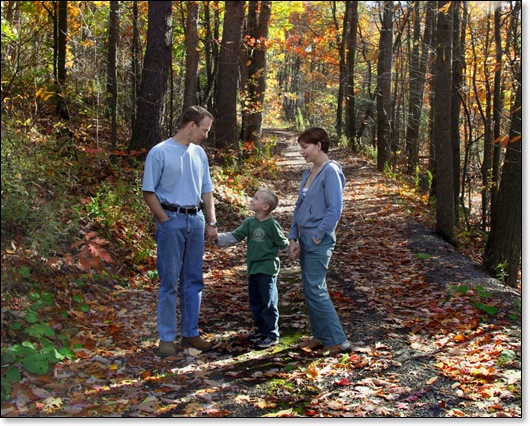
Jacob's father is a staff member at Garrett College, which is located a few miles from my house at Deep Creek Lake, MD. The Allen family lives in Morgantown, WV, about 40 minutes from Deep Creek. Morgantown also is the home of my daughter Julie, son-in-law Chris Frum, and grandson Lusas. Julie and Chris are West Virginia University grads, and Chris works at the University in Morgantown. As soon as the word got out, volunteers from WVU, Garrett College, churches, and other groups converged on the wilderness area to look for Jacob under the guidance of first responders and professional rescue organizations. Chris, who has extensive wilderness training and experience, served as a team leader on day 3 of the search. Miraculously, Jacob was found by just such a team on day 4, only hours before the a driving rainstorm snapped the spell of unseasonably warm weather that had kept hopes alive that Jacob could survive the elements if help came in time.
According to Chris, so many qualified people came out to help -- not to mention folks who just wanted to do anything -- that the organizers had to make up tasks to keep them busy. Many, he said, took time away from their hourly jobs, so they lost a day's pay for every day they spent searching for Jacob. Though he was armed with a hand-held GPS, Chris said that the terrain was so rugged he was very concerned that one of his 15-member team could get lost in an instant, so the team relied on shout-outs to stay together. It took nearly a day to cover terrain that was roughly the size of a football field. The fact that a watchful rescue-team member finally spotted Jacob, as he slept beneath the canopy of rhododendron, was almost a miracle in itself.
The story of the Allen family's plight and Jacob's rescue made national news for nearly a week. But what happened at Dolly Sods continues to touch those who participated directly in the rescue operation as well as those who held the family and the searchers in their hearts and prayers throughout the ordeal. A website that commemorates the search can be found at www.operationjacob.com. If you're having a bad day, just visit the site and click on the slide show, as what unfolds will surely lift your spirits. It's hard to top the sight of Jacob and his rescuers emerging from that endless wilderness.
Chris, Julie and Lucas came to visit in Deep Creek the day after Jacob was found. I took this picture of them over the weekend. It now has special meaning because it will forever remind me a beautiful, unseasonable October when good people came together and became part of something much larger than themselves.

The Power of the Internet . . . and the Good People Who Use It
September/25/2007
I thrive on
stress . . . except for technology stress. For almost
a week now I've been dealing with technology upgrades
that, thank heavens, are almost finished. I've been
complaining about the ensuing chaos to anyone who
would listen. This morning I received a kind and
supporting email from my dear friend
Helen Yancy who posed this
rhetorical question: "What was life like before
computers?" I can't remember, but I know I got
more sleep back then.
A few minutes ago another dear friend, Steve Troup, president of my lab, Buckeye Color Lab in North Canton, Ohio, sent me a link to a great story that has at least partially adjusted my attitude about the worth of advanced technology . . . in this case the Internet, which has given me such fits during the last week. If you've had bad technology days, then I think you'll enjoy reading this short article. Perhaps it will improve your day in the same way it did mine.
Thanks Steve!
A few minutes ago another dear friend, Steve Troup, president of my lab, Buckeye Color Lab in North Canton, Ohio, sent me a link to a great story that has at least partially adjusted my attitude about the worth of advanced technology . . . in this case the Internet, which has given me such fits during the last week. If you've had bad technology days, then I think you'll enjoy reading this short article. Perhaps it will improve your day in the same way it did mine.
Thanks Steve!
On An Ordinary Tuesday - 9/11/01
September/11/2007
I'm so glad
it rained today.
Six years ago I was about to leave my house to run some errands . . . a doctor's appointment and preparations for an upcoming Guerrilla Management Workshop at my lake house in Deep Creek Lake, Maryland. I was on my way out the door when the phone rang: It was my fellow instructor, Judy Grann, who said, "Are you watching TV . . . something's happened in New York."
I clicked on the TV just in time to see a plane smash into the second tower. I was horrified, but I was late for my appointment, so I jumped in the card and turned on the radio. By the time I arrived at the doctor's office, the Pentagon had been hit. People in this tiny mountain community were visibly shaken, as they thought the fall of the Berlin Wall had finally removed the specter of an attack on Washington. Because I didn't grow up in Deep Creek, I had never given a second thought to the fact the this peaceful region lies within the fall-out zone of a nuclear attack on Washington, D.C. I was pretty calm. After all, I had grown up in a military family and participated in countless evacuation drills when we lived abroad. I knew that bad things could happen, but you just kept moving.
I was fine, that is, until I heard that a plane had flown into the ground in Shanksville, PA, just 60 miles from Deep Creek. At that moment I was seized by a panic to get back to the house and reach my husband and kids on the phone. In the back of my mind, I thought "they" were coming for ALL of us. The next few days were a blur . . . making sure my grown kids knew what to do if the attacks kept coming . . . trying to decide what to do about the upcoming class when planes weren't flying . . . watching TV coverage non-stop . . . hearing the awful news that the pilot of American Airlines flight #77, which hit Pentagon, was the older brother of one of our clients.
Somehow, six stalwart photographers who were within a reasonable driving distance of Deep Creek, made it to the Workshop. Judy and I were grateful for their perseverance, as the class helped to restore a bit of normalcy, although it was hard for all of us to concentrate, when you really wanted to turn on the news. It was as if seeing the towers fall down again and again would lead us to understand what had happened on that incredibly beautiful blue-sky Tuesday.
For the past two weeks, the weather — from New York to Deep Creek — has made the news: Everyone marveled that not a drop of rain fell on the U.S. Open in Flushing Meadows. The lake has never been more beautiful. Driving back to PA from our Deep Creek holiday, I couldn't help but be reminded of the kind of day it was on 9-11-01, and I started to feel the same unease that I have felt on beautiful September days ever since.
The streak of lovely weather ended today, and I was so glad to see the rain. The unease was still there, so I started visiting 9-11 memorial websites, where I learned they are still trying to raise money for a memorial to the souls who were lost in Shanksville. I stopped surfing after I came across a memorial site that I had visited before: http://www.voicesofsept11.org, on the 911 Reflections/songs & poems page. There, I landed on a series of songs written in memory of the day. One of them—On An Ordinary Tuesday—seemed to sum up my thoughts today. It was written by Sharon, Arthur, Margie, Alton Corey & Jeff Hodge and performed by Buddy Jewell, Copyright 2002 Sharomar Music. Here's a link if you'd like to listen.
The song was soothing today. So was the rain.
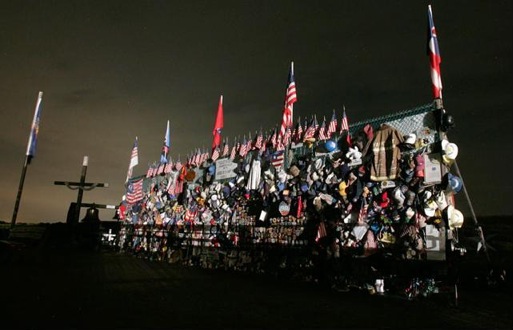
Temporary memorial to United Flight 97 in Shanksville, PA
Six years ago I was about to leave my house to run some errands . . . a doctor's appointment and preparations for an upcoming Guerrilla Management Workshop at my lake house in Deep Creek Lake, Maryland. I was on my way out the door when the phone rang: It was my fellow instructor, Judy Grann, who said, "Are you watching TV . . . something's happened in New York."
I clicked on the TV just in time to see a plane smash into the second tower. I was horrified, but I was late for my appointment, so I jumped in the card and turned on the radio. By the time I arrived at the doctor's office, the Pentagon had been hit. People in this tiny mountain community were visibly shaken, as they thought the fall of the Berlin Wall had finally removed the specter of an attack on Washington. Because I didn't grow up in Deep Creek, I had never given a second thought to the fact the this peaceful region lies within the fall-out zone of a nuclear attack on Washington, D.C. I was pretty calm. After all, I had grown up in a military family and participated in countless evacuation drills when we lived abroad. I knew that bad things could happen, but you just kept moving.
I was fine, that is, until I heard that a plane had flown into the ground in Shanksville, PA, just 60 miles from Deep Creek. At that moment I was seized by a panic to get back to the house and reach my husband and kids on the phone. In the back of my mind, I thought "they" were coming for ALL of us. The next few days were a blur . . . making sure my grown kids knew what to do if the attacks kept coming . . . trying to decide what to do about the upcoming class when planes weren't flying . . . watching TV coverage non-stop . . . hearing the awful news that the pilot of American Airlines flight #77, which hit Pentagon, was the older brother of one of our clients.
Somehow, six stalwart photographers who were within a reasonable driving distance of Deep Creek, made it to the Workshop. Judy and I were grateful for their perseverance, as the class helped to restore a bit of normalcy, although it was hard for all of us to concentrate, when you really wanted to turn on the news. It was as if seeing the towers fall down again and again would lead us to understand what had happened on that incredibly beautiful blue-sky Tuesday.
For the past two weeks, the weather — from New York to Deep Creek — has made the news: Everyone marveled that not a drop of rain fell on the U.S. Open in Flushing Meadows. The lake has never been more beautiful. Driving back to PA from our Deep Creek holiday, I couldn't help but be reminded of the kind of day it was on 9-11-01, and I started to feel the same unease that I have felt on beautiful September days ever since.
The streak of lovely weather ended today, and I was so glad to see the rain. The unease was still there, so I started visiting 9-11 memorial websites, where I learned they are still trying to raise money for a memorial to the souls who were lost in Shanksville. I stopped surfing after I came across a memorial site that I had visited before: http://www.voicesofsept11.org, on the 911 Reflections/songs & poems page. There, I landed on a series of songs written in memory of the day. One of them—On An Ordinary Tuesday—seemed to sum up my thoughts today. It was written by Sharon, Arthur, Margie, Alton Corey & Jeff Hodge and performed by Buddy Jewell, Copyright 2002 Sharomar Music. Here's a link if you'd like to listen.
The song was soothing today. So was the rain.

Temporary memorial to United Flight 97 in Shanksville, PA